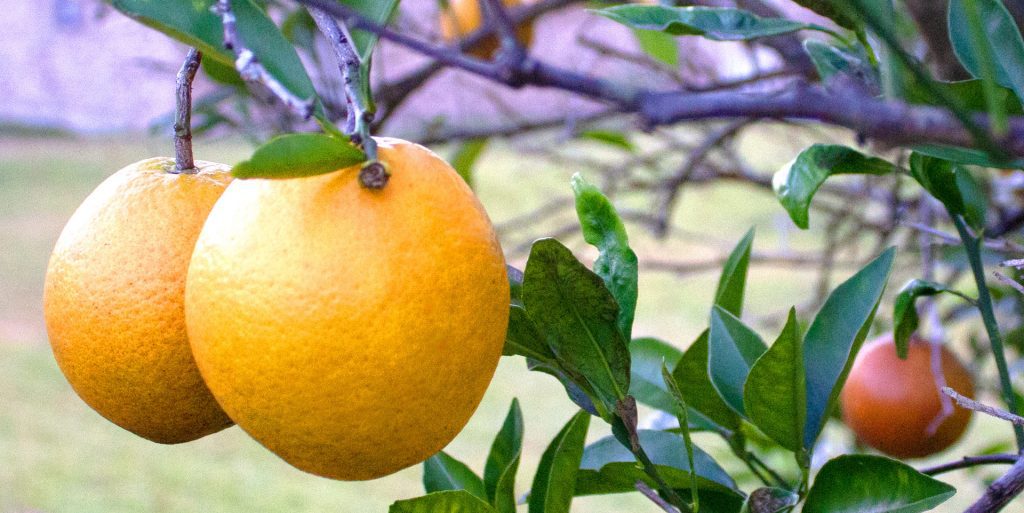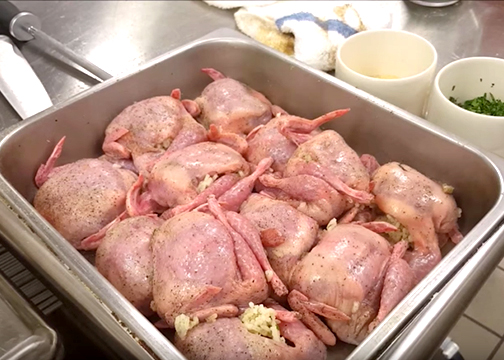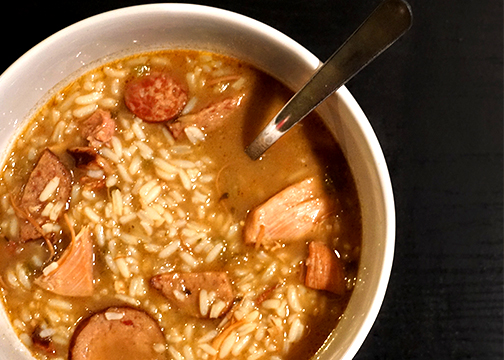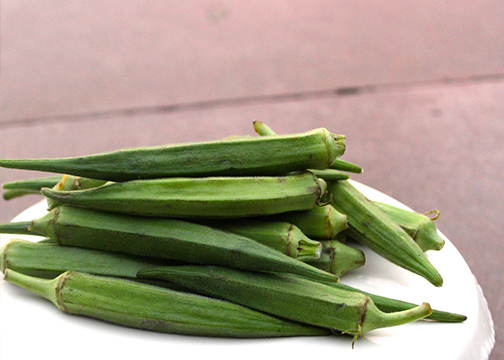Orangecello // Louisiana Mandarin Style

Mandarin Orangecello Prep Time10 min Cook Time5 min Total Time15 min Ready in7-10 days Yield1 bottle INGREDIENTS 12 mandarin oranges 750 ml Everclear (a fifth/one bottle) 2 cups sugar Instructions 1 Wash and dry the mandarin oranges. Remove the rinds and place them in a pitcher. Pour the Everclear into the pitcher with the rinds and let them soak for 7-10 days before bottling. Before bottling, make a simple syrup by mixing 2 cups of sugar with 3 ¾ cups of hot water. Pour the simple syrup into a separate pitcher and let it sit in the refrigerator until cool. Strain the rind/Everclear mixture and mix it with the simple syrup once it has cooled. Bottle and enjoy!
First // You Make a Roux…

by Melanie Cowan, Special Sections Editor The start to any good gumbo or bisque is a ROUX— it is sac religious to think otherwise in South Louisiana. A roux is the foundation used to thicken stocks and is most commonly used to make gumbo. Most rouxs start by continuously stirring flour and a type of fat (either butter or oil) to get a desired color. It is, in fact, a labor of love that shines through Cajun dishes and has been an art form of sorts for decades. There are a few ways to make a good roux and most Cajuns will claim their method is better than the next. THE FIRST METHOD is an oil-less way of making a roux in the oven. All that is needed is two cups of all purpose flour. Start by preheating the oven to 350 degrees fahrenheit, then spread the flour evenly along the bottom of a cast iron skillet. Bake, stirring the mixture occasionally for about an hour until the desired color is reached. When the color is reached, let cool on a cookie sheet until needed. ANOTHER TRADITIONAL METHOD of making a roux is the Brown Roux method of mixing ½ cup of flour to ½ cup of butter together in a sauté pan. First melt the butter over medium-high heat. Slowly add flour stirring constantly until flour becomes light brown. The key here is stirring constantly because flour can become easily scorched and the roux will be unusable. If black specks show up in the roux, it is scorched and cannot be used. THE LAST COMMONLY USED METHOD of making a roux is the Oil Base Roux. This recipe calls for 1 cup of vegetable oil to 1 cup of flour. It is prepared the same way as a Brown roux, however, it will taste different. The color of a roux varies greatly as well and it is dependent on what the roux will be used for. A Blonde Butter Roux is cooked to a golden color, a White Butter Roux is cooked to a barley beige color, a Light Brown Cajun Roux which is light brown in color, and a Dark Brown Cajun Roux. A dark brown roux is usually used for gumbo. No matter the color, they are all helpful in the thickening of any Cajun dish that uses stock. Take a look at the video above to learn more on how to make a proper Cajun roux. https://youtu.be/65eKEIAdd1E
Gumbo // Practice Makes Perfect

by Emily Clausen, Guest Contributor
A Cajun Staple // Gumbo

by Andetrie Vicks, Staff Writer Today when family and friends in Louisiana get together to enjoy each other’s company the style of cooking is still CAJUN/CREOLE. Traditional comfort foods are on the menu, like red beans and rice, fried catfish and most importantly gumbo. Gumbo is extremely diverse and every family makes it slightly different with their preference of meats, spices, and thickener. In the beginning this tasty elixir was made by the people of South Louisiana, but it was just a simple soup using meats and vegetables cooking in water. Gumbo history reveals that African American imported okra found its way into the Louisiana kitchens, and provided gumbo with its name; Gumbo is the African word for okra. It was discovered that okra boosted the flavor, but more importantly it added some texture in the way of a thickening agent. Later people found that flour browned in pig lard added a great color, texture and taste. This is where roux first made its appearance and changed gumbo history. Since then roux has become the dominant agent to thicken this famous Louisiana dish as nothing can match the colors and flavors as deep. Another way of thickening is by adding the ground leaves from the sassafras tree: Filé. This fine seasoning was adopted from the local Choctaw Indians. The powder is added right before serving and adds a hearty taste that gumbo lovers seek. Gumbo differs from bowl to bowl but one thing always remains the same, it is a Louisiana classic enjoyed by many. This is a recipe for a chicken sausage gumbo, one of the many variations of this dish. Chicken and Sausage Gumbo Yield8 servcings INGREDIENTS 1 cup vegetable oil 1 cup all-purpose flour 2 onions chopped 1 green bell pepper chopped 1 yellow bell pepper chopped 4-5 celery stalks chopped 3 cloves garlic minced 1 lb Andouille or smoked sausage chopped and browned 1-2 lbs chicken cooked 10 cups chicken broth 2 bay leaves 1 tbsp Kitchen Bouquet 1 tbsp Cajun seasoning 2 tbsp parsley white rice Instructions 1 Heat the oil in a large pot over medium heat, add in the flour and whisk constantly until the mixture is smooth and brown. This forms the Roux. The roux will burn very easy if it’s not moving. Once roux is brown add onions, and cook for 5 minutes. Add the bell peppers and celery, and cook for 5 more minutes. Stir in the Kitchen Bouquet, garlic, sausage and Cajun seasoning and cook another 5 minutes. Add the chicken broth and bay leaves to the pot and bring it to a boil. Let the gumbo simmer for one hour. After an hour add parsley and cooked chicken to the gumbo and simmer 1 more hour Remove excess oil from the top of gumbo. Serve hot over white rice. People often add Filé, hot sauce, and salt and pepper to their individual bowls.
Dance In The Kitchen ‘Till The Morin Light // Recipes

by Katie Fletcher, Special Sections Editor The kitchens of South Louisiana are blessed with some of the best chefs in the world. The food is just as spicy and diverse as the people who prepare it. It’s southern food with extra flavor, extra calories, and extra love. Everybody’s grandma makes the greatest gumbo, and everybody’s dad boils the best crawfish. Here are a couple of things that make the food down here a little bit different. THE TRINITY It all starts with the holy trinity. I’m not talking about religion; I’m talking about the sacred mixture of onions, bell peppers, and celery. These three vegetables are the backbone to many South Louisiana dishes. The smell of the trinity cooking can instantly make a mouth water and a crowd form in the kitchen around the old cast iron pot it’s cooking in. The trinity is usually, but not always broken down into two small onions, one large bell pepper, and three to four ribs of celery. The trinity is chopped and sautéed to create the base for jambalaya, gumbo, étouffée, stew, sauce piquante, and so many other Louisiana favorites. MEASUREMENTS Recipes in South Louisiana are passed down from generation to generation. Whether they are scribbled down or memorized they are held close to the hearts of the people that enjoy them. When a recipe is written down it is often times hard to recreate because the measurements are not the average teaspoon, cup, or oz. My grandma, like many other Cajuns, has her own measuring system. I have tried countless times to cook her recipes but they never come out the same. There’s something about the way she does things that makes everything taste just right. Over the years I have watched her cook and her measurements can be roughly translated to: “A pinch of salt.” About a teaspoon, she uses this measurement when she’s adding salt to bread dough, or a pot of food. “Equal parts flour and oil.” About ¾ cup of each to make a roux for a Gumbo or stew, it gets a little tricky when it’s an extra large gumbo for the whole family. “A handful or two.” About a cup to two cups, this can be anything from nuts in a bread pudding to crawfish tails in a bisque. “A dash of. “ About ¼ teaspoon, usually referring to spicy ingredients like Cayenne and Tabasco. “Just enough to cover.” About two cups of rice and three and a half cups of water. To transfer the rice to the pot she always uses a plastic parade cup, that’s about as far as measuring cups go for “A heaving spoonful” About a tablespoon, she uses this measurement when talking about sugar, but she always sneaks in a little more. Her motto: “It can never be too sweet.” MEAT AND SEAFOOD Food doesn’t get much more local than Louisiana. From a young age, children are taught how to peel crawfish and shrimp. They know to how to ‘pinch the tails’ before they know how to tie their shoes. Food here is fresh and seasonal. Fish are caught the same day they are fried. Louisiana is covered in water making it the perfect place for fishing. People spend hours fishing their favorite spots to bring home ice chests of fish to clean and eat. Crabs are picked apart to get the ‘good meat’ for soups and stews. Oysters are very popular and can be served many different ways. A common way is too shuck it and eat it raw straight from the shell with hot sauce or ketchup. The meat around here can get kind of wild. Sure we eat chicken, pork and beef, but to some South Louisianans turtle, alligator, and frog legs are delicacies. It’s not uncommon for chili to be made with deer meat or for duck to be served with rice and gravy. People take pride in catching and hunting their food and are always willing to throw it in a pot and share it with family and friends. Cuisine in Louisiana is still cooked the way it has been for years, slow and seasoned. It’s made with love and served in huge portions. Invite people over and enjoy one of these recipes. Louisiana food is an experience that allows people to stop from their busy day, sit down with family, and enjoy food that is rich with flavor and soul.
